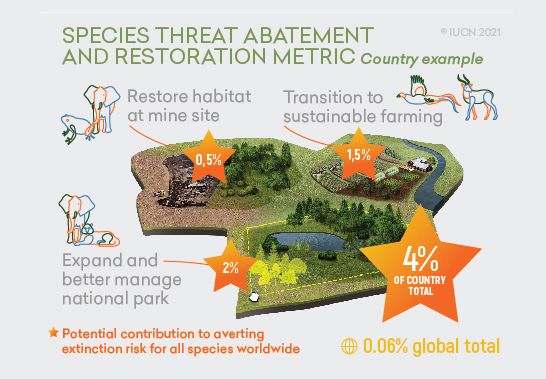How the Red List is Used
The IUCN Red List shows us where and what actions need to be taken to save the building blocks of nature from extinction. It provides a straightforward way to factor biodiversity needs into decision-making processes by providing a wealth of useful information on species.
Guiding scientific research
Scientific journals regularly cite The IUCN Red List in peer-reviewed literature. Each year numerous new conservation articles examine the values of The IUCN Red List and refer to its important contribution to conservation planning. Downloads of IUCN Red List data from the website show that academics from research institutions worldwide export IUCN Red List data for research purposes on a daily basis.

Informing policy and conventions
The IUCN Red List is used to inform decisions taken by Multilateral Environmental Agreements. It is often used as a guide to revise the annexes of some important international agreements, such as the Convention on International Trade in Endangered Species (CITES) and the Convention on Migratory Species (CMS).
Data from The IUCN Red List are used to calculate the Red List Index (RLI), which is one of the biodiversity indicators used by the Convention on Biological Diversity (CBD) to monitor progress towards achieving the Kunming-Montreal Global Biodiversity Framework (GBF) targets for 2030.
The IUCN Red List also provides data for the indicators needed to measure progress towards the achievement of the United Nations Sustainable Development Goals (SDGs), particularly Goal 15.
The IUCN Red List assessments of freshwater species have also contributed to the work of the Ramsar Convention in selecting sites that are important for freshwater biodiversity.
The IUCN Red List contributes to the function of the Intergovernmental science-policy Platform on Biodiversity and Ecosystem Services (IPBES) to strengthen the science-policy interface on biodiversity and ecosystem services to improve decision making.
Influencing resource allocation
The Global Environment Facility (GEF) has included information from The IUCN Red List in its resource allocation framework since 2008. Other foundations and funding instruments, such as the Critical Ecosystem Partnership Fund (CEPF); SOS - Save Our Species; and Mohamed bin Zayed Species Conservation Fund, also use data from assessments on The IUCN Red List to guide their investments in conservation.
Informing conservation planning 
Several conservation planning methodologies use The IUCN Red List to identify Key Biodiversity Areas (KBAs) for conservation including: Important Bird Areas; Important Plant Areas; and Alliance for Zero Extinction (AZE) sites. For example, one of the criteria that AZE sites must meet is that they contain at least one Endangered or Critically Endangered species, as listed on The IUCN Red List.
Improving decision-making
The IUCN Red List can help inform environmental impact assessments, which are often used to inform decision-makers of the potential environmental consequences of implementing proposed projects. For example, data from The IUCN Red List are included in the Integrated Biodiversity Assessment Tool (IBAT), an innovative decision support tool available to both the business and conservation sectors. The wealth of information on habitats and threats to species is also used in biodiversity management and site rehabilitation planning processes.
Combining conservation planning analyses with information on threats from The IUCN Red List has also led to partnerships with industry to explore opportunities to reduce the negative impact on biodiversity and promote more sustainable production. Initiatives developed in collaboration with the petrochemical, mining, aggregate and financial sectors, such as Net Positive Impact (NPI), benefit from access to Red List information on the distribution of species and their conservation status.
The Species Threat Abatement and Restoration (STAR) metric also uses data from the IUCN Red List in a way that allows governments, cities, civil society, the finance industry, investors and companies to quantify the potential impact of their actions on reducing species extinction risk. National governments can use STAR to set baselines for measuring progress towards global biodiversity targets; conservation agencies can use it to identify gaps and target conservation efforts; and the private and financial sectors can use STAR to document and disclose biodiversity risk.
Education and raising awareness
New information from The IUCN Red List generates significant media interest resulting in a wealth of articles appearing on the internet, in printed newspapers, on television and radio, and in special interest magazines, which helps to raise public awareness of the plight of species and the larger environmental issues surrounding them. The international networks of zoos, aquariums and botanic gardens are helping to raise awareness of species conservation and The IUCN Red List by displaying current IUCN Red List status on their species information signs. Teachers and students of all ages use The IUCN Red List website for class work and projects. The IUCN Red List inspires artists to create installations and original works of art highlighting the extinction crisis and threats to biodiversity. Poets, writers and musicians also use The IUCN Red List as a source of inspiration.
Contributing to human health and livelihoods
Information on The IUCN Red List contributes to human health and livelihoods. Red List data are often used by researchers in the health sector investigating the distributions of species that are known or suspected vectors of human and domestic-animal diseases. This helps them to develop models on predicted future occurrences of the diseases and work towards effective solutions.
Many species assessed for the Red List are also key species for human health and livelihoods. For example, assessment projects that focus on medicinal plants and crop wild relatives help to highlight those species that have the potential to develop new medicines and to secure the future of agricultural crops in a changing climate. Highlighting the status of such species and working towards securing their future also helps to secure our own future.
“The IUCN Red List tells us where
we ought to be concerned and
where the urgent needs are to do
something to prevent the despoliation
of this world. It is a great agenda
for the work of conservationists.”
Sir David Attenborough


